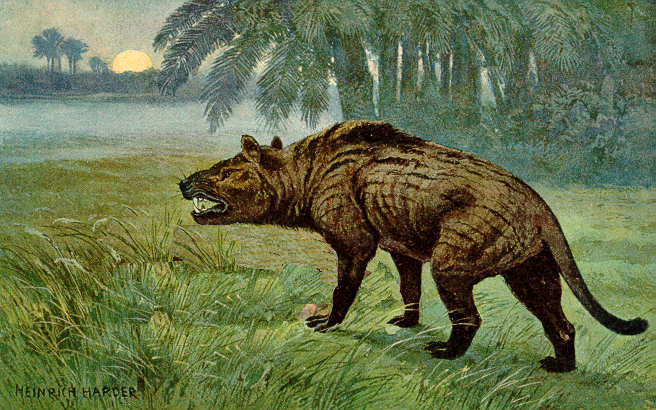Advertisement
Hyaenodon Scientific Classification
- Kingdom
- Animalia
- Phylum
- Chordata
- Class
- Mammalia
- Order
- creodonta
- Family
- Hyaenodontidae
- Genus
- Hyaednodon
- Scientific Name
- Hyaenodon leptorhynchus
Read our Complete Guide to Classification of Animals.
Hyaenodon Conservation Status
Hyaenodon Facts
- Diet
- Omnivore
Hyaenodon Physical Characteristics
View all of the Hyaenodon images!
Hyaenodons are ancient carnivorous mammals that ruled the land in their day.
The Hyaenodon was one prolific genus that lived in Eurasia and North America. Over 30 species within the genus showed the diversity and evolution of these animals. With features and behavior similar to modern-day hyenas, they actually weren’t related to hyenas at all.

The Hyaenodon was an ancient carnivorous mammal.
Hyaenodon Species, Types, and Scientific Name
Hyaenodon is an extinct genus within the Hyaenodontidae family. There were over 30 species within the genus. The type species, Hyaenodon leptorhynchus, was discovered and named in the 1830s. Other species include:
- Hyaenodon brachyrhychus
- Hyaenodon chunkhtensis
- Hyaenodon dubius
- Hyaenodon eminus
- Hyaenodon filholi
- Hyaenodon gervaisi
- Hyaenodon heberti
- Hyaenodon minor
- Hyaenodon pervagus
- Hyaenodon pumilus
- Hyaenodon requieni
- Hyaenodon rossignoli
- Hyaenodon weilini
- Hyaenodon yuanchuensis
- Hyaenodon gigas
- Hyaenodon horridus
- Hyaenodon incertus
- Hyaenodon macrocephalus
- Hyaenodon megaloides
- Hyaenodon milvinus
- Hyaenodon mongoliensis
- Hyaenodon montanus
- Hyaenodon vetus
- Hyaenodon brevirostrus
- Hyaenodon crucians
- Hyaenodon microdon
- Hyaenodon mustelinus
- Hyaenodon raineyi
- Hyaenodon venturae
While they had many similarities, the type species is the best example to study to determine what these animals looked like and how they lived. Scientists identify a type species for most ancient animals to compare it to other genera.
The Hyaenodon belonged to Creodonta order. Despite the similarity of its name to the modern hyena, they are not related. Animals in the Creodonta order had long skulls and slim bodies. They were all carnivores. They are all extinct.
Hyaenodonta was part of the Mammalia class. This is the first place where they are related to hyenas, which belong to the Hyaenidae family. Both are part of the phylum Chordata and kingdom Animalia.
Hyaenodon
| Kingdom | Animalia | |
| Phylum | Chordata | |
| Order | Creodonta | |
| Family | Hyaenodontidae | |
| Genus | Hyaenodon | |
| Species | Hyaenodon leptorhynchus and others |
Description and Size
Hyaenodon had a large skull with a long snout. This was characteristic of members of the Hyaenodonta order and many ancient carnivores. Their skulls were on the longer side compared to others in their family.
Because the species of Hyaenodon are so diverse, there is a large size range of these animals. Some were as large as 800 pounds. Others were closer to modern-day weasel sized, around 10 pounds. The largest specimen belongs to H. gigas. It was around 10 feet long and 833 pounds. The smaller specimens are H. microdon and H. mustelinus. Their fossils show that they were closer to 11 pounds.
Hyaenodon teeth were sharp and pointed, ideal for tearing into meat. Their front teeth were particularly formidable and perfect for shearing meat from bone. While their jaws were large, they were not as strong as some other predators, which probably meant that they didn’t spend much time crushing bones.
Their bodies were similar to dogs. But their teeth, however, were more like those of modern-day cats.
Diet – What Did Hyaenodon Eat?
These animals were carnivores and ate meat. They had large jaws that could snap the neck of their prey with just one bite. Depending on the exact species, their size could be a helpful feature to take down prey. The larger Hyaenodon species were probably some of the largest carnivores in their environment. This meant that they would have eaten other mammals, such as entelodonts and bear-dogs.
How do scientists know so much about the Hyaenodon diet? They can examine teeth specimens to determine what kind of food they evolved to eat. Hyaenodon teeth were sharp and powerful. Bone analysis can also shed light on what kind of nutrients these animals may have gotten from their diet.
Habitat – When and Where It lived
Amazingly, Hyaenodon were some of the longest-living and most widespread ancient mammals. This explains how so many species of various sizes developed. They evolved over millions of years to adapt to various environments and resources.
The earliest Hyaenodon specimens date to the Middle Eocene epoch, around 42 million years ago. They evolved and migrated throughout the world for almost 20 million years. Later specimens show that they lived in the Late Oligocene epoch, around 25 million years ago.
They lived in Eurasia and what is now North America. Fossilized remains of Hyaenodon have been found all around the world. This shows not only that they migrated but that they evolved in different ways depending on the environment. The most notable difference between the species within the genus is their size.
Threats and Predators
Just like their diet depended on their size, the potential predators that could have made the Hyaenodon into a meal also varied. For the larger species, such as H. gigas, there were not as many predators in their environment that could have taken them on. Other carnivorous mammals may have fought with Hyaenodon. These include entelodonts and bear-dogs, which were also prey for hungry Hyaenodon.
Smaller species would have had more predators. Many larger carnivores could have made a tasty meal out of the 10-pound H. microdon. Remember that they still had sharp teeth and powerful jaws, however. These would have made even the smaller species tough prey to defeat.
A discovery in North Dakota of a saber-tooth cat bone with bite marks shows that Hyaenodon fought with these animals as either prey or predator. They also competed with each other for resources and mating rights.
Young Hyaenodon
Like all mammals, Hyaenodon gave birth to live young. They would have been particularly vulnerable to predators during this time. Not only were they smaller and weaker, but their sharp teeth also were not present until adulthood. It took three or four years for all of their teeth to come in. This long period of adolescence made them vulnerable to other predators.
Discoveries and Fossils – Where It was Found
The Hyaenodon was first discovered and named in 1838. Despite it having no relation to the modern hyena, scientists named it Hyaenodon, which means “hyena-tooth” in Greek. Its fossils have been found all over Europe, Asia, and North America. They have also been dated to between 42 and 25 million years ago. With such a broad range of time and space, numerous species have been identified and classified.
Fossilized remains show that Hyaenodon lived in what is now North Dakota around 30 million years ago. Their well-documented specimens have been studied to find out how these animals lived. The fossils discovered in North Dakota were around four feet long, one of the larger species of Hyaenodon.
Small Hyaenodons also existed in North America. H. venturae and H. microdon were both discovered in Wyoming. The specimens are from the Late Eocene.
Extinction – When Did It Die Out?
The latest discovered specimens of Hyaenodon are from around 25 million years ago. They likely went extinct near the end of the Oligocene epoch. Researchers believe that the species in Eurasia went extinct first. They were followed by the North American species.
Why did the Hyaenodon, once so prolific, go extinct? It probably had too much competition for resources. Because they did not develop to run for great distances, they would have had a hard time competing with other carnivores who did develop this feature. Due to this adaptation, carnivores who could run longer and faster would have gotten the better choice of prey. Hyaenodon eventually went extinct.
Similar Animals to the Hyaenodon
- Simbakubwa: These Hyaenodonta were larger than Hyaenodon and native to present-day Africa. They had similar features and lived around 22 million years ago. They were also carnivores and likely dominated the landscape of their day.
- Hyainailouros: Not much is known about this Creodont. But it had similar features and thrived just after the Hyaenodon, during the Miocene epoch. It may have been one of the animals that competed with Hyaenodon for resources that led to the latter’s eventual extinction.
UP NEXT:
View all 104 animals that start with HHyaenodon FAQs (Frequently Asked Questions)
When did Hyaenodon live?
These ancient carnivores lived around 42 to 25 million years ago. Their remains have been dated from the Middle Eocene epoch to the Late Oligocene epoch.
How big was a Hyaenodon?
Because they lived over such a long period of time and evolved based on their environment, Hyaenodons could be as small as 10 pounds or as large as 800 pounds. Their length ranged from 1 foot to 10 feet.
Thank you for reading! Have some feedback for us? Contact the AZ Animals editorial team.

















